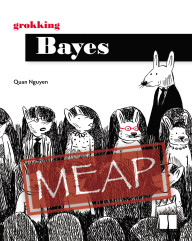books & videos by Quan Nguyen
Bayesian Optimization in Action Video Edition
Bayesian Optimization in Action teaches you how to create efficient machine learning processes using a Bayesian approach. In it, you’ll explore practical techniques for training large datasets, hyperparameter tuning, and navigating complex search spaces. This interesting book includes engaging illustrations and fun examples like perfecting coffee sweetness, predicting weather, and even debunking psychic claims. You’ll learn how to navigate multi-objective scenarios, account for decision costs, and tackle pairwise comparisons.
Grokking Bayes
Grokking Bayes teaches Bayesianism through clear explanations, rich illustrations, and relatable examples. You’ll first build an intuition, and then translate that intuition into working code with Python tools like the PyMC library and ArviZ package. Along the way, you’ll explore how Bayesian ideas connect to modern AI, from uncertainty-aware deep learning to LLM applications.
Throughout, the book focuses on the skills for making better decisions: you’ll go from inference, to Bayesian decision theory, and even experimental design. Whether you’re a data scientist, AI practitioner, or curious learner, Grokking Bayes will give you the tools to make smarter decisions without needing to rely on long-run frequencies or reams of data without drowning you in probability theory and abstract math.
Bayesian Optimization in Action
Bayesian Optimization in Action teaches you how to create efficient machine learning processes using a Bayesian approach. In it, you’ll explore practical techniques for training large datasets, hyperparameter tuning, and navigating complex search spaces. This interesting book includes engaging illustrations and fun examples like perfecting coffee sweetness, predicting weather, and even debunking psychic claims. You’ll learn how to navigate multi-objective scenarios, account for decision costs, and tackle pairwise comparisons.



